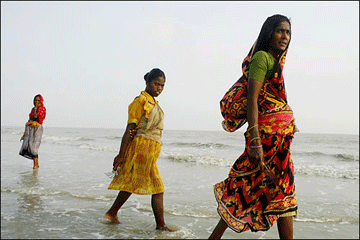
Muslim women search the beaches of Sagar Island for coins thrown into the waters of the Ganges by Hindu pilgrims. Heathcliff O’Malley/Telegraph Media Group © 2007
This morning’s news is predictable deja vu: another car bomb explodes in Iraq killing at least 20 people, the Taliban are poppying up again in Afghanistan, children are still starving in Darfur as their mothers get raped, Somalia is summarily consigned to old news since no new soldier bodies have been paraded in the streets. Page two… So much killing, so much religious faith spread around the ever warming globe, and seemingly so little dialogue for God’s children. But here’s a story from where the river bends, the Ganges of India that is, at the last bend it makes into the sea. Here is a river so holy to Hindus that it is viewed as alive, if not life itself, prompting both the devout and the just-following-the-nabob-mob to toss rupees into the polluted current. As Philip Reeves reports for NPR today, this all results in real change (if you dig hard enough in the sand) for a few of the poorest of India’s 150 million plus Muslims.
Here is the synopsis of the report, click here to listen to the full radio report.
Morning Edition, April 6, 2007 ·
Our journey down the Ganges ends on Sagar Island, where the river meets the sea. Once a year, millions of Hindus come here to worship Mother Ganga and to toss coins into her waters.
For this five-part series, we have traveled the length of the river — more than 1,500 miles — to describe the physical and spiritual sustenance it provides to hundreds of millions of people, and to find out what those people think about the way India is changing.
One especially worrisome change is a dramatic and widening income gap between rural India and areas where the economy is thriving.
Asura Bibi, a 40-year-old woman searching for coins in the sands of Sagar Island, knows this imbalance all too well. She depends on the loose change she finds here to feed her three children.
Daniel Martin Varisco